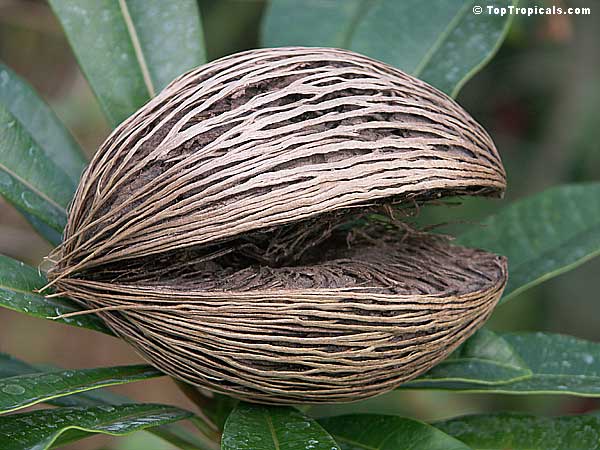BACKGROUND:A variety of plants contain cardiac glycosides. This has resulted in many of them being used to commit suicide.
In southeast Asia, Cerebera odollam (pong-pong or suicide tree) is frequently used for suicidal ingestion. Seeds, or kernels, of this plant can cause hyperkalemia, heart block, and death due to the effects of its cardiac glycosides. CASE REPORT:We describe six cases of pong-pong seed ingestion reported to US poison centers. The most common symptoms were vomiting and bradycardia.
Three patients survived and three died. All patients who died had heart block, serum digoxin levels 1.0 ng/mL, and were treated with anti-digoxin immune FAB. Anti-digoxin immune FAB may be ineffective in a large pong-pong seed ingestion. Patients ingesting pong-pong seeds who develop a potassium level 8.0 meq/L or have a digoxin level 1.0 ng/mL may be at a higher risk for death. WHY SHOULD AN EMERGENCY PHYSICIAN BE AWARE OF THIS?: The apparent ease of acquiring C.
Odollam seeds on the Internet makes knowledge of it important, as it can be used as a means to commit suicide. The apparent failure of digoxin immune FAB to treat toxicity from pong-pong is important, as other lifesaving techniques, such as extracorporeal membrane oxygenation, might be needed in severely toxic patients.Copyright © 2018 Elsevier Inc. All rights reserved.
World of warships blitz download for pc. Contents.Common names Cerbera odollam is known by a number of vernacular names, depending on the region. These include othalam (ഒതളം) in the Malayalam language used in Kerala, India; kattu arali (காட்டரளி) in the adjacent state of Tamil Nadu; famentana, kisopo, samanta or tangena in Madagascar; and pong-pong, buta-buta, bintaro or nyan in Southeast Asia.
Description Cerbera odollam bears a close resemblance to, another highly toxic plant from the same family. Its branchlets are whorled about the trunk, and its leaves are terminally crowded, with tapering bases, acuminate apices, and entire margins. Game dev tycoon torrent. The plant as a whole yields a milky, white latex.Its fruit, when still green, looks like a small, with a green fibrous shell enclosing an ovoid kernel measuring approximately 2 cm × 1.5 cm and consisting of two cross-matching white fleshy halves. On exposure to air, the white kernel turns violet, then dark grey, and ultimately brown, or black.Toxicity. Flowers of Cerbera odollamThe kernels of C. Odollam contain, a -type and toxin that blocks the in, causing disruption of the heart beat, most often fatally. The most common symptom of toxicity in humans was noted to be vomiting.
Electrocardiographic abnormalities were noted to be common, the most common being. Around half of the patients develops thrombocytopenia. Temporary cardiac pacing has been used in the management, apart from other supportive measures. The difficulty in detecting cerberin in and the ability of strong to mask its taste makes it an agent of and in; there were more than 500 cases of fatal Cerbera poisoning between 1989 and 1999 in the southwest Indian state of.A fatal dose of the poison is contained in one kernel, leading to death within 1–2 days.Common symptoms include:. burning sensation in mouth. violent vomiting.

irregular respiration. headache. irregular heartbeat.
Seeds for sale starting at € 11.20. A very attractive small to medium-sized tree, related and somewhat similar to the Frangipani (Plumeria), with dark green, glossy leaves and white, very fragrant flowers that are followed by large, round, thin skinned fr.
coma and eventual deathUses The fruits are used for manufacturing bioinsecticides and deodorants. Investigations have also been made into the feasibility of using the seeds as a feedstock in the production of. See also.References Wikimedia Commons has media related to.
^ Gaillard Y, Krishnamoorthy A, Bevalot F., 2004, 'Cerbera odollam: a 'suicide tree' and cause of death in the state of Kerala, India,' J. Menon, M Suraj (2016). 17 (4): 136–139. – via Wolters Kluwer - Medknow. James Randerson, 2004, 'Suicide tree' toxin is 'perfect' murder weapon' commentary on Gaillard, et al., 2004, op. Cit., New Scientist (online), November 26, 2004, see, accessed 18 June 2015. P.I.
Rajeev, 2007, '‘Suicide fruit’ now a rich harvest?,' The Indian Express (online), February 3, 2007, see, accessed 18 June 2015. Sarah Kaplan, 2015, 'Morning Mix: The brutal harvest of India’s ‘suicide tree’,' The Washington Post (online), May 8, 2015, see, accessed 18 June 2015. Kansedo, Jibrail; Lee, Keat Teong; Bhatia, Subhash (2009). 'Cerbera odollam (sea mango) oil as a promising non-edible feedstock for biodiesel production'. 88 (6): 1148–1150.